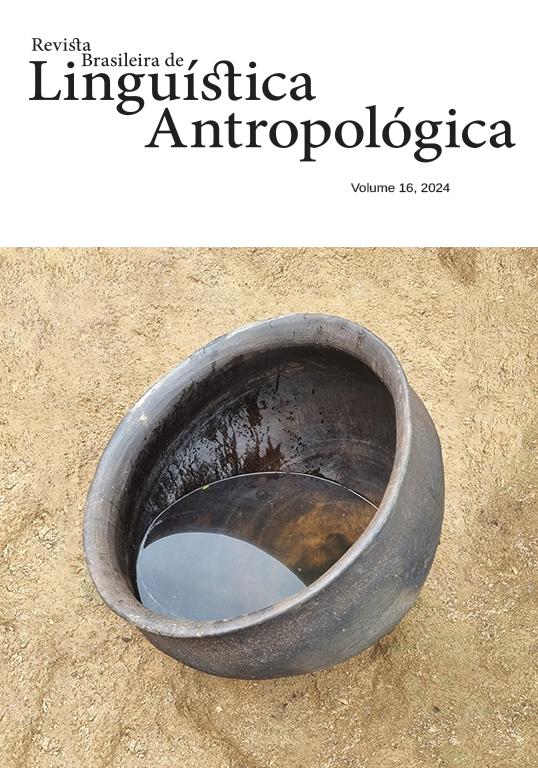Re-discussing nasality in Mehináku (Arawak)
DOI:
https://doi.org/10.26512/rbla.v16i1.55314Keywords:
Língua Mehináku, Língua Arawak, Nasalidade fonética, Nasalidade fonológica, Rediscutindo a nasalidadeAbstract
In this paper, I re-discuss the process of nasality in the Mehinaku (Arawak) language. To do this, I present examples of phonetic and phonological nasality in this language. Regarding phonetic nasality, I argue that its spread occurs from right to left, therefore occurring in a regressive way, and reaching vowels to the left of a nasal consonant. Phonological nasality, in turn, is also regressive, and I do not consider that there is an opposition in Mehinaku between oral and nasal vowels. I argue that phonological nasality is guided by the loss of a nasal consonant from the syllabic Onset which, when it disappeared, left traces of nasality on the vowels of the preceding syllables. The Mehinaku language belongs to the Arawak family and is spoken by a people of the same name, who currently live in the Xingu Indigenous Territory.
References
Aikhenvald, Alexandra. 1999. The Arawak language family. In: Dixon, R. M. W. & Aikhenvald, Alexandra (eds.). The Amazonian languages. (pp. 65-102). Cambridge: Cambridge University Press.
Carvalho, Fernando Orphão de. 2016. Internal and Comparative Reconstruction in Yawalapiti: Palatalization and Rule Telescoping. International Journal of American Linguistics, v. 82, 285-316.
Corbera Mori, Angel Humberto. 2006. Relações entre grafemas e segmentos nos vocabulários Waurá e Mehináku de Steinen (1866[1940]). Revista de Estudos da Linguagem. UESB. Bahia, n.3, 143-157.
Corbera Mori, Angel Humberto. 2009. Sobre a nasalidade de vogais em Mehináku. Estudos linguísticos, São Paulo, 38(1), 213-222.
Corbera Mori, Angel Humberto. 2012. Waurá e Mehináku: um breve estudo comparativo. Estudos Linguísticos, São Paulo, 41 (1), 196-205.
Maddieson, Ian. 1984. Patterns of Sounds. Cambridge University Press.
Mujica, Mitzila I. 1992. Ortega. Aspectos fonológicos e gramaticais da língua Yawalapiti (Aruak). 1992. Dissertação (Mestrado em Linguística). Instituto de Estudos da Linguagem, Universidade Estadual de Campinas, Campinas.
Myazaki, N. 1965. The Waura and Mehinaku - Ethnological Study of two Aruak tribes in the Upper Xingu, State Mato Grosso, Brazil. Manuscrito. Japan, Tókio.
Myazaki, N. 1966. The Waurá and Mehinaku. Tese (PhD in Linguistics). University of Tokyo.
Payne, David L. 1991. A classification of Maipuran (Arawakan) languages based on shared lexical retentions. In Derbyshire, Desmond C. & Pullum, Geoffrey K. (eds.). Handbook of Amazonian Languages (vol. 3, pp. 355-499). Berlin, New York: Mouton de Gruyter.
Postigo, Adriana Viana. 2014. Língua Wauja (Arawak): uma descrição fonológica e morfossintática. 2014. Tese (doutorado em Linguística). Faculdade de Ciências e Letras, Universidade Estadual Paulista, Araraquara.
Richards, Joan. 1988. A estrutura verbal Waurá. Série Linguística, vol. 2, n. 9, 192-218.
Richards, Joan. 1973. Dificuldades na análise da possessão nominal na língua Waurá. Série Linguística, n. 1, 11-29.
Richards, Joan. 1977. Orações em Waurá. Série Linguística, n. 7, 141-184.
SILVA, Teresa Cristina De Souza. 1990. Estudo Preliminar Da Fonologia Da Língua Mehináku. Dissertação de mestrado. UNB, Brasília, 49f.
Downloads
Published
Issue
Section
License
Copyright (c) 2024 Revista Brasileira de Linguística Antropológica

This work is licensed under a Creative Commons Attribution 4.0 International License.
Authors who publish in RBLA agree to the following terms:
a) Authors maintain the copyright and grant the journal the right of first publication, and the work is simultaneously licensed under the Creative Commons Attribution License, which allows the sharing of the work with recognition of the authorship of the work and initial publication in this journal.
b) Authors are authorized to assume additional contracts separately, for non-exclusive distribution of the version of the work published in this journal (eg, publish in an institutional repository or as a book chapter), with recognition of authorship and initial publication in this journal.
c) Authors are allowed and encouraged to publish their work online (eg, in institutional repositories or on their personal page) at any point before or during the editorial process, as this can generate productive changes, as well as increase impact and citation of the published work.










